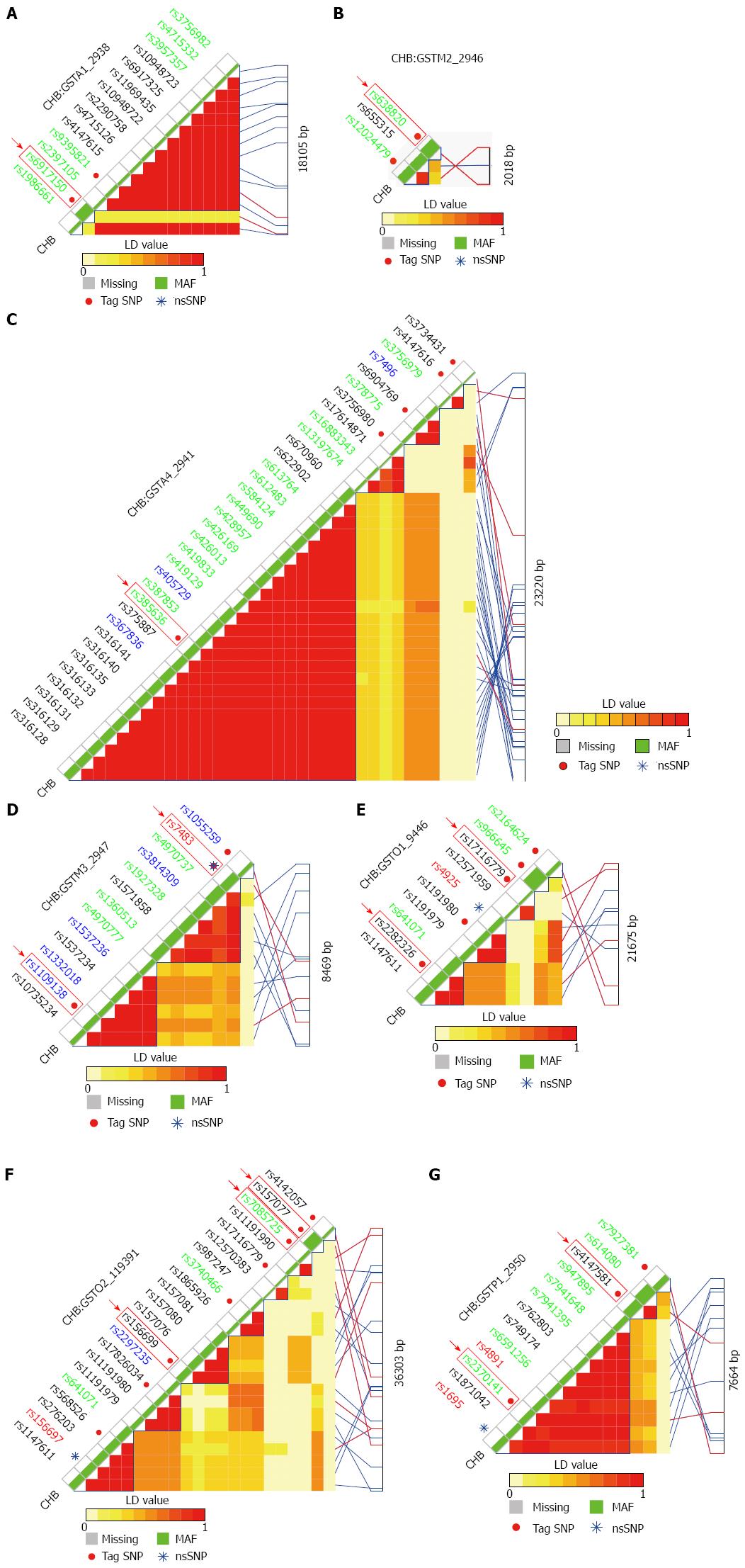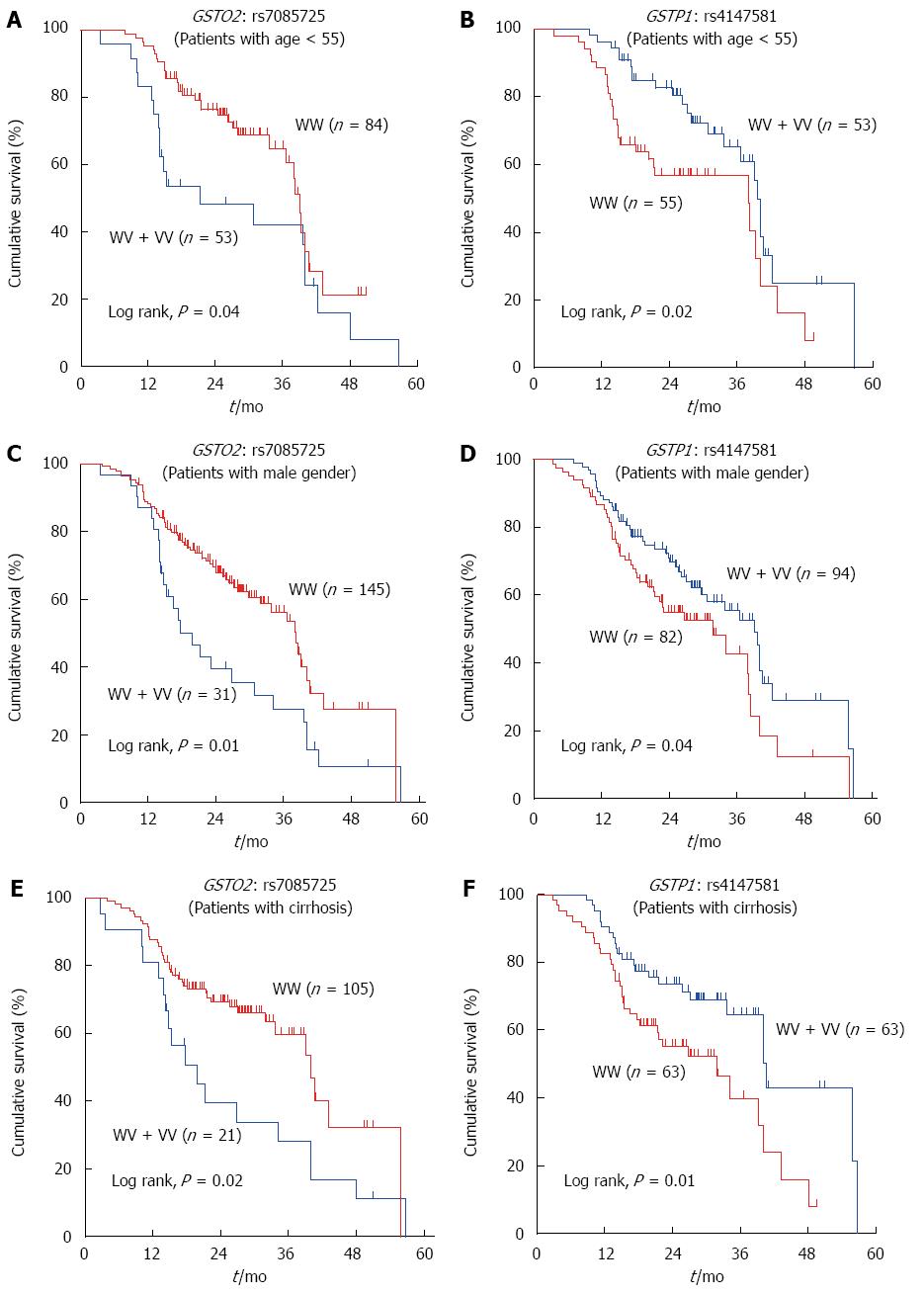Copyright
©The Author(s) 2015.
World J Gastroenterol. Apr 14, 2015; 21(14): 4310-4322
Published online Apr 14, 2015. doi: 10.3748/wjg.v21.i14.4310
Published online Apr 14, 2015. doi: 10.3748/wjg.v21.i14.4310
Figure 1 Relevant pictures of polymorphisms in seven GST genes.
A: GSTA1 (Gene ID: 2946); B: GSTM2 (Gene ID: 2946); C: GSTA4 (Gene ID: 2941); D: GSTM3 (Gene ID: 2947); E: GSTO1 (Gene ID: 9446); F: GSTO2 (Gene ID: 119391); G: GSTP1 (Gene ID: 2950). Genotype data were obtained from HapMap database (http://hapmap.ncbi.nlm.nih.gov) and SNPs were sorted by LD similarity using NIEHS tools (http://snpinfo.niehs.nih.gov). Twelve selected SNPs were labeled by red block.
Figure 2 Kaplan-Meier curves for hepatocellular carcinoma patients carrying genetic variants of GSTO2: rs7085725 (A) and GSTP1: rs4147581 (B).
WW: Homozygous wild-type genotype; WV: Heterozygous genotype; VV: Homozygous variant genotype.
Figure 3 Kaplan-Meier curves for hepatocellular carcinoma patients carrying genetic variants of GSTO2: rs7085725 and GSTP1: rs4147581 in stratified subgroups.
A and B: In patients with age < 55 years; C and D: In patients with male gender; E and F: In patients with cirrhosis. WW: Homozygous wild-type genotype, WV: Heterozygous genotype; VV: Homozygous variant genotype.
Figure 4 Kaplan-Meier curves for hepatocellular carcinoma patients carrying unfavorable genotypes.
A: In all patients; B: In patients with age < 55 years; C: In patients with male gender; D: In patients with cirrhosis. Patients were classified into two groups, according to number of unfavorable genotypes carried. Group 1 + 2 carried 0 or 1 unfavorable genotype, while Group 3 carried 2 unfavorable genotypes. Unfavorable genotypes were GSTO2: rs7085725 (WV or VV) and GSTP1: rs4147581 (WW).
Figure 5 Kaplan-Meier curves for hepatocellular carcinoma patients carrying WV + VV genotypes in different smoking subgroups.
A: HCC patients were classified by smoking behavior; B: HCC patients were classified by smoking quantity. WV: Heterozygous genotype; VV: Homozygous variant genotype.
Figure 6 Comparison of genotype distribution in hepatocellular carcinoma patients with different GSTO2 and GSTP1 expression.
A: rs7085725 genotype distribution in different GSTO2 expression groups. rs7085725 genotype was predicted according to rs11191994 (LD r2 = 1.000, D’ = 1.000); B: rs4147581 genotype distribution in different GSTP1 expression groups. rs4147581 genotype was predicted according to rs614080 (LD r2 = 1.000, D’ = 1.000). WV: Heterozygous genotype; VV: Homozygous variant genotype; NS: Not significant.
- Citation: Qu K, Liu SS, Wang ZX, Huang ZC, Liu SN, Chang HL, Xu XS, Lin T, Dong YF, Liu C. Polymorphisms of glutathione S-transferase genes and survival of resected hepatocellular carcinoma patients. World J Gastroenterol 2015; 21(14): 4310-4322
- URL: https://www.wjgnet.com/1007-9327/full/v21/i14/4310.htm
- DOI: https://dx.doi.org/10.3748/wjg.v21.i14.4310














